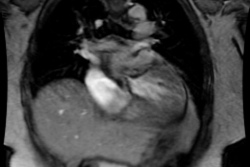Cor Triatriatum:
Clinical:
Cor
triatriatum is a rare lesion due
to failure
of the
common pulmonary vein to incorporate normally into the left
atrium (cor triatriatum sinister [4]). A fibromuscular
septum arising from the interatrial
septum and extending toward the atrial
free wall
separates the embryologic common pulmonary vein from the left
atrium.
The
resultant accessory chamber lies posterior/superiorly (above
the level
of the left atrial appendage [3]) and receives pulmonary
veins. The membrane interposed between the left atrium and
pulmonary
veins
produces obstruction to venous return. The anteroinferior
chamber contains the atrial
appendage and
the mitral
valve [2].
Patients
present with dyspnea, CHF, and
failure to
thrive
(symptoms are similar to mitral valve stenosis).
There
is good results following surgical
correction. However,
if left untreated, 75% of patients will die in infancy because
of
secondary
pulmonary hypertension [2]. The lesion is associated with
other
congenital
heart disease such as an ASD (secundum
type
[2]),
PDA, and coronary sinus malformations [2].
More rarely, the condition can also affect the right atrium (cor
triatriatum dexter) [4].
X-ray:
The
radiographic findings vary with the degree of obstruction. CXR
findings
include
pulmonary venous distention and interstitial edema and left atrial
enlargement. The pulmonary trunk/arteries dilated in severe
obstruction. The RA
and RV also enlarge.
REFERENCES:
(1) Seminars in Roentgenology 1989;
Budorick NE, et al. The
pulmonary veins.
24 (2) Apr: 127-140
(2) J Cardiovasc Comput
Tomogr 2011; Rojas CA, et al.
Cardiac CT of
non-shunt
pathology of the interatrial
septum. 5:
93-100
(3) Radiographics 2012; Vyas HV, et al. MR imaging and CT
evaluation
of
congenital pulmonary vein abnormalities in neonates and infants.
32:
87-98
(4) Radiographics 2019; Rajiah P, et al. Bands in the heart: multimodality imaging review. 39: 1238-1263





